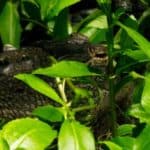Last updated on September 22nd, 2023 at 08:10 pm

There are many quiet spots and hiking paths to enjoy the beautiful natural surroundings. A few of our favorites include Lettuce Lake Park, Wheedon Island Nature Preserve, and the Sunken Gardens in St. Petersburg.
Lettuce Lake Park
 Lettuce Lake Park covers 240 acres in northeast Tampa. More than half of the park’s property lies in the natural floodplain of the Hillsborough River. The park consists of a hardwood swamp forest, hardwood hammocks, and pine flatwoods plant communities full of local wildlife.
Lettuce Lake Park covers 240 acres in northeast Tampa. More than half of the park’s property lies in the natural floodplain of the Hillsborough River. The park consists of a hardwood swamp forest, hardwood hammocks, and pine flatwoods plant communities full of local wildlife.
If you visit on the weekend, start at the Audubon Center to learn more about the habitats along the Hillsborough River. Be sure to pick up a brochure with a map of the park, then begin your journey on the boardwalk system that meanders through the floodplain forest.
We like to walk the following loop around the boardwalk and nature path:
- Turn right at the T intersection and pass massive cypress trees on your way to a side trail that ends at a sheltered cove where you can sit and watch the herons and alligators.
- When you rejoin the intersection, continue straight until you reach a junction where a cypress is encircled by the boardwalk.
- Turn right following the river, and at just under a mile you’ll reach the observation tower. Climb five stories for a birds-eye view of Lettuce Lake.
- The boardwalk only continues a tenth of a mile past the tower.
- Continue on the loop by walking down past the paved bike trail to the nature trail.
In addition to experiencing the nature walk, you can also rent kayaks, and fish, or take a $5 guided nature tour. Bring your own bike if you want to ride the 1.5-mile bike trail.
Weedon Island Preserve Cultural & Natural History Center
 One of our favorite spots for hiking and kayaking is Weedon Island Preserve. The preserve includes a four-mile kayak trail through mangroves and into the secluded inlets. It also has a three-mile hiking trail along with a fishing pier and waterfront picnic sites.
One of our favorite spots for hiking and kayaking is Weedon Island Preserve. The preserve includes a four-mile kayak trail through mangroves and into the secluded inlets. It also has a three-mile hiking trail along with a fishing pier and waterfront picnic sites.
Weedon Island Preserve combines a wonderful nature experience on a site with fascinating historical significance. The Cultural and Natural History Center features classrooms and exhibit areas designed by anthropologists, historians, and Native Americans to reflect the art and history of the area’s first people, the Timucuans and Manasotas who made the island their home. The center combines a look at artifacts excavated from the site by the Smithsonian in the 1940s, as well as the chance to experience aspects of Native American culture in the exhibit gallery.
You can hike the interpretive and boardwalk trails on your own or join in a guided hike. Boardwalks extend through tidal flats and mangrove forests, providing viewing opportunities over saltwater ponds, which are often teeming with mullet and wading birds. The paved portion connecting the two boardwalk loops takes visitors through a pine flatwoods community as it passes by the Weedon Island Preserve Cultural and Natural History Center. Along the west boardwalk loop stands a 45-foot observation tower. On a clear day, this tower provides visitors with an excellent view of the preserve and the Tampa Bay area.
 You can rent a kayak or launch your own to enjoy the preserve’s South Paddling Trail, a four-mile loop that meanders through mangroves and seagrass flats and between islands of the preserve and along the edge of Tampa Bay.
You can rent a kayak or launch your own to enjoy the preserve’s South Paddling Trail, a four-mile loop that meanders through mangroves and seagrass flats and between islands of the preserve and along the edge of Tampa Bay.
Sunken Gardens in St. Petersburg, FL

An oasis in the midst of St. Petersburg, the Sunken Gardens is considered the city’s oldest living museum and home to some of the oldest tropical plants in the region.
The gardens were originally founded in 1903 by a plumber named George Turner, Sr. He drained an ancient lake on the property, leaving a rich muck soil that was ideal for his hobby – gardening. Then he created the garden amidst an elaborate maze of clay tiles. Neighbors enjoyed strolling through Mr. Turner’s garden so much, that he started charging a nickel for tours. Three generations of the Turner family continued the tradition until the city of St. Petersburg purchased Sunken Gardens in 1999. Today the garden features more than 50,000 tropical plants (representing more than 500 species), plus flamingos and other exotic birds.
Be sure to check out their website for the wide range of free tours and talks from learning inventive ways to collect rainwater to tips for improving your nature photography. If you are interested in the beaches in the area check out our post on the 5 best beaches in the Tampa Bay area. All of our other Florida posts can be found here.












